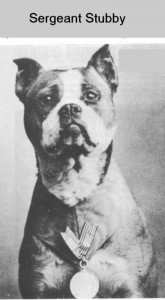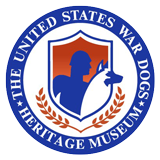
Sergeant Stubby
America’s first war dog, Stubby, served 18 months ‘over there’ and participated in seventeen battles on the Western Front. He saved his regiment from surprise mustard gas attacks, located and comforted the wounded, and even once caught a German spy by the seat of his pants. Back home his exploits were front page news of every major newspaper.
Stubby was a bull terrier – broadly speaking, very broadly! No one ever discovered where he hailed from originally. One day he just appeared, when a bunch of soldiers were training at Yale Field in New Haven, Ct; he trotted in and out among the ranks as they drilled, stopping to make a friend here and a friend there, until pretty soon he was on chummy terms with the whole bunch.
One soldier though, in particular, developed a fondest for the dog, a Corporal Robert Conroy, who when it became time for the outfit to ship out, hid Stubby on board the troop ship.
So stowaway Stubby sailed for France, after that Cpl. Conroy became his accepted master, even though he was still on chummy terms with everyone else in the outfit; and in the same spirit of camaraderie that had marked his initial overtures at Yale.
It was at Chemin des Dames that Stubby saw his first action, and it was there that the boys discovered he was a war dog par excellence. The boom of artillery fire didn’t faze him in least, and he soon learned to follow the men’s example of ducking when the big ones started falling close. Naturally he didn’t know why he was ducking, but it became a great game to see who could hit the dugout first. After a few days, Stubby won every time. He could hear the whine of shells long before the men. It got so they’d watch him!
Then one night Stubby made doggy history. It was an unusually quiet night in the trenches. Some of the boys were catching cat naps in muddy dugouts, and Stubby was stretched out beside Conroy. Suddenly his big blunt head snapped up and his ears pricked alert. The movement woke Conroy, who looked at the dog sleepily just in time to see him sniff the air tentatively, utter a low growl, then spring to his feet, and go bounding from the dugout, around a corner out of sight.
A few seconds later there was a sharp cry of pain and then the sound of a great scuffle outside. Conroy jumped from his bed, grabbed his rifle and went tearing out towards the direction of the noise.
A ludicrous sight met his eyes. Single-pawed, in a vigorous offensive from the rear, Stubby had captured a German spy, who’d been prowling through the trenches. The man was whirling desperately in an effort to shake off the snarling bundle of canine tooth and muscle that had attached itself to his differential. But Stubby was there to stay.
It took only a few moments to capture the Hun and disarm him, but it required considerably more time to convince Stubby that his mission had been successfully carried out and that he should now release the beautiful hold he had on that nice, soft German bottom.
By the end of the war, Stubby was known not only to every regiment, division, and army, but to the whole AEF. Honors by the bale were heaped on his muscled shoulders. At Mandres en Bassigny he was introduced to President Woodrow Wilson, who “shook hands” with him. Medal and emblemed jackets were bestowed upon him for each deed of valor, plus a wound stripe for his grenade splinter. Not to be left out, the Marines even made him an honorary sergeant.
After the Armistice was signed, Stubby returned home with Conroy and his popularity seemed to grow even more. He became a nationally acclaimed hero, and eventually was received by presidents Harding and Coolidge. Even General John “Black Jack” Pershing, who commanded the American Expeditionary Forces during the war, presented Stubby with a gold medal made by the Humane Society and declared him to be a “hero of the highest caliber.”
Stubby toured the country by invitation and probably led more parades than any other dog in American history; he was also promoted to honorary sergeant by the Legion, becoming the highest ranking dog to ever serve in the Army.
He was even made an honorary member of the American Red Cross, the American Legion and the YMCA, which issued him a lifetime membership card good for “three bones a day and a place to sleep.”
Afterwards, Stubby became Georgetown University’s mascot. In 1921, Stubby’s owner, Robert Conroy was headed to Georgetown for law school and took the dog along. According to a 1983 account in Georgetown Magazine, Stubby “served several terms as mascot to the football team.” Between the halves, Stubby would nudge a football around the field, much to the delight of the crowd.
Old age finally caught up with the small warrior on April 4th, 1926, as he took ill and died in Conroy’s arms.
It’s said, that Stubby and a few of his friends were instrumental in inspiring the creation of the United States ‘K-9 Corps’ just in time for World War ll.
Hahn’s 50th AP K-9, West Germany
